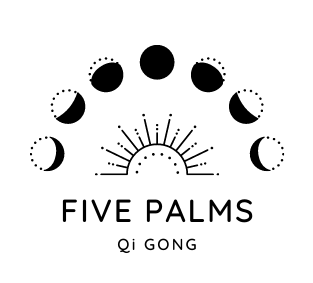Introduction to the Five Palms Qi Gong Form
“A thousand mile journey begins with a single step”
Lao Tzu
Qigong, an ancient Chinese healing practice that was originally a martial art, has been developed and used to improve physical fitness and strength in China for 7000 years.
The word “qigong” involves two theories: “qi,” the vital energy of the body and “gong,” the training or cultivation of qi.
Concentration, relaxation, meditation, breathing regulation, and body posture and movements are the basic components of qigong.
In contrast to conventional exercise, qigong aims to achieve a harmonious flow of qi in the body and cultivate a spirit of systematic training exercise to improve physical fitness and overall well-being through the coordination of rhythmic movements, regulated breathing, and meditation.
There are essentially two types of qigong: internal and external. Internal qigong or qigong exercise is self-directed and involves the use of movements, meditation, and controlled breathing patterns, whereas external qigong is typically performed by experienced practitioners who use their hands to direct qi on to patients for healing or treatment.
Typically, qigong can be classified into dynamic and static qigong. Dynamic qigong involves the coordination of movements and meditation, whereas static qigong focuses on mental concentration and body relaxation without physical movements.
Meridians are associated with the under-differentiated, interconnected cellular networks that regulate growth and physiology. The meridian theory explains the distribution and non-specific activation of organizing centers, acupuncture points, and the high electrical conductance of the meridians.
In the human body, meridian theory deals with physical regulation and pathological changes. The condition of the meridian system can be measured by its electrical characteristics which have been studied since the 1950s. Acupuncture points have been widely accepted as areas of low electrical impedance and high conductance. Skin conductance response is typically measured by applying a small direct current signal through two electrodes placed on the skin.
Qigong exercise significantly relieved anxiety and reduced stress among healthy people. Long-term practice of qigong exercise may help in maintaining satisfactory health and preventing and treating illness. Qigong exercise has been reported to influence depression, stress, anxiety symptoms, chronic pain, immunity, infection, and quality of life.
2018, Evidence-Based Complementary and Alternative Medicine, ‘Acute Physiological and Psychological Effects of Qigong Exercise in Older Practitioners’
By Chun-Yi Lin,Tze-Taur Wei, Chen-Chen Wang, Wan-Chen Chen, Yu-Min Wang, and Song-Yen Tsa
